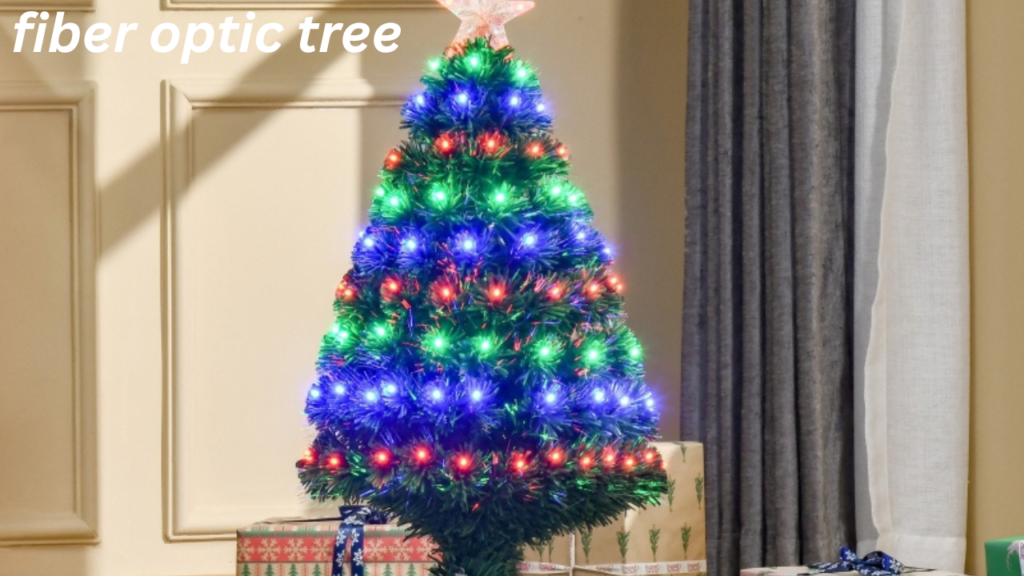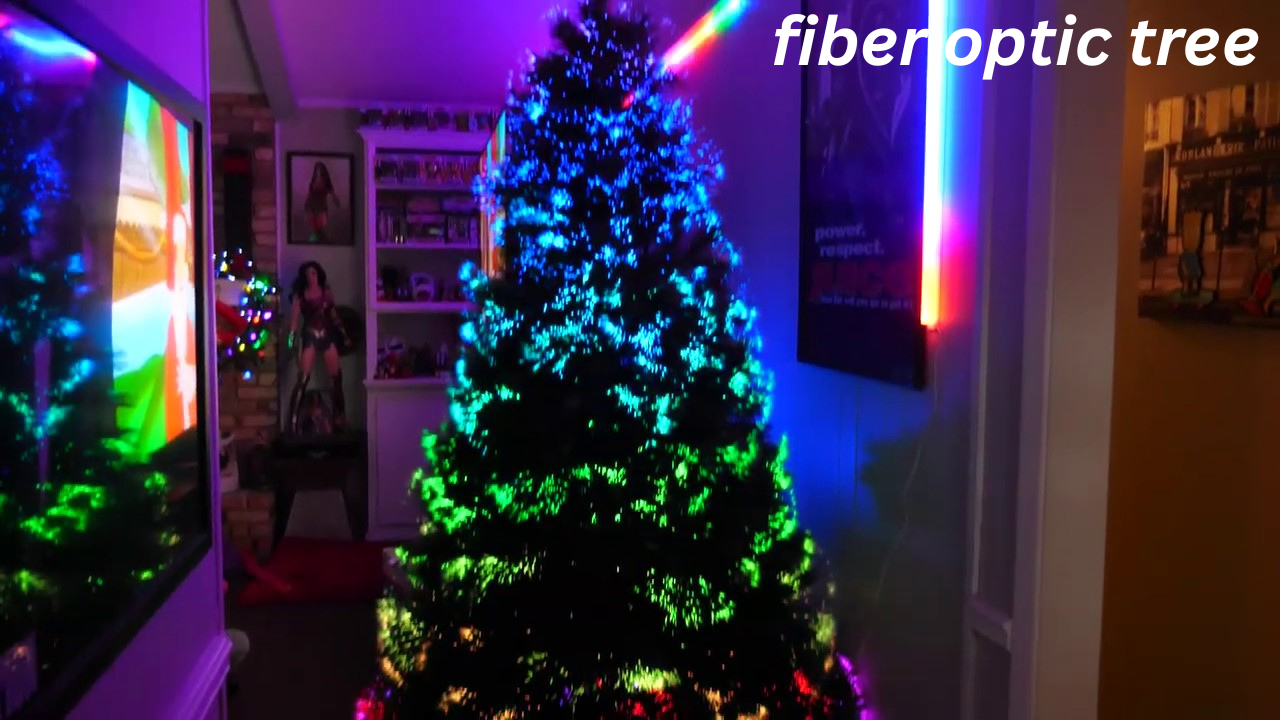Fiber optic trees have become a popular alternative to traditional Christmas trees, offering a modern twist on a festive classic. Whether you’re looking to reduce maintenance, save on energy, or simply add a unique lighting effect to your holiday decor, a fiber optic tree might be the perfect addition to your home. This guide will explore everything you need to know about fiber optic trees, from their origins to choosing the right one for your space and maintaining it long-term.
What is a Fiber Optic Tree?

Definition and How It Works
A fiber optic tree is an artificial tree that uses fiber optics to create stunning light effects. Unlike traditional Christmas trees, which are decorated with string lights, fiber optic trees have built-in fiber strands that transmit light along their length. These fibers are connected to a light source (usually an LED light at the base of the tree) that shines through the fibers, creating glowing tips and shimmering effects throughout the branches.
The light travels along the fibers and emerges at the tips, giving the tree a sparkling, multi-colored effect that can be mesmerizing to look at. Fiber optic trees come in various sizes and shapes, and the light source can be programmed to change colors or remain fixed, depending on the model. This modern technology provides a unique and vibrant display of light that is hard to achieve with conventional Christmas tree lights.
Types of Fiber Optic Trees
There are several different types of fiber optic trees, and choosing the right one depends on your preferences, available space, and budget. The two main types are pre-lit fiber optic trees and fully fiber optic trees. Pre-lit trees still have traditional branches and are often combined with fiber optics to enhance the lighting, while fully fiber optic trees are constructed entirely from fibers that emit light.
These trees can also vary by design—some have a classic pine look, while others take on abstract or modern forms. When shopping for a fiber optic tree, you’ll also find options with color-changing LEDs, which offer the flexibility of customizing your tree’s lighting display. Additionally, fiber optic trees come in different sizes, so you can choose one for your living room, office, or even a small tabletop display.
Choosing the Right Fiber Optic Tree
Size and Placement Considerations
When selecting a fiber optic tree, size is one of the most important factors. Fiber optic trees come in a range of heights, from small tabletop trees that can fit on a desk or mantle to larger, full-sized trees that stand several feet tall. Consider the space where you want to place the tree—if you have a small apartment or limited room, a smaller tree may be ideal. On the other hand, larger trees can make a bold statement and become the centerpiece of your holiday decorations.
Placement is also key—fiber optic trees look stunning when positioned in living rooms, entryways, or corners where the light effects can be fully appreciated. Ensure that the tree is placed in a spot where it won’t be obstructed by furniture or walls, as this can limit the visual impact of the light display. If you plan on using the tree outdoors, look for models designed for outdoor use, as they are built to withstand weather conditions.
Style and Color Options
Fiber optic trees come in a variety of styles, so it’s easy to find one that matches your holiday theme or home décor. Traditional trees with lifelike pine branches are common, but there are also modern variations, including trees with a minimalist design or spiral shapes. These alternative designs are perfect for contemporary settings or homes with a more avant-garde aesthetic.
Additionally, color options are an essential consideration. Many fiber optic trees come with multi-colored LEDs, which can create a vibrant and dynamic light show. Some trees allow you to customize the color sequence or choose from preset modes that cycle through different hues. If you prefer a more subdued look, there are also single-color fiber optic trees that shine in warm whites or cool blues, providing a more elegant and timeless atmosphere.
Setting Up and Maintaining Your Fiber Optic Tree
Assembly Tips
One of the main advantages of fiber optic trees is that they are easy to assemble. Most trees come with pre-installed lights and fiber optic strands, so setting up your tree is straightforward. Simply attach the tree’s base to the trunk, arrange the branches, and plug it in. While the setup process is typically hassle-free, make sure to follow the manufacturer’s instructions carefully, especially if the tree requires any specific assembly steps.
It’s important to fluff the branches to ensure the fibers are evenly spread out and visible from all angles. This will allow the light to shine evenly and create a more visually striking effect. If you have a pre-lit tree, double-check that all the fiber optic strands are intact and that no lights are flickering before setting it up.
Cleaning and Storage
Though fiber optic trees are relatively low-maintenance, they do require occasional cleaning to keep the fibers free from dust and debris. To clean the tree, use a soft, dry cloth to gently wipe down the branches and fibers. Avoid using water or cleaning products, as these can damage the fibers or light source. If your tree is equipped with removable parts, like a detachable base or stand, you can disassemble it for easier cleaning.
When the holiday season is over, proper storage is essential for maintaining the longevity of your tree. Carefully disassemble the tree, making sure to keep all parts intact. Store the tree in a cool, dry place, away from direct sunlight or damp environments. It’s a good idea to place the tree in a protective bag or box to prevent dust accumulation and potential damage.
Top Fiber Optic Trees on the Market
While there are many brands and models of fiber optic trees, some stand out for their quality, features, and affordability. Here are some top picks:
- Balsam Hill’s Fiber Optic Christmas Tree – Known for its realistic pine branches and vibrant color-changing lights, this tree is a favorite for those seeking a traditional look with modern features.
- National Tree Company Fiber Optic Tree – With its affordable pricing and easy setup, this tree is a popular choice for budget-conscious shoppers.
- GKI/Bethlehem Lighting Fiber Optic Tree – This high-end model is perfect for those who want a premium tree with extra customization options, including a remote control for light settings.
Conclusion
Fiber optic trees are a modern and visually striking alternative to traditional Christmas trees. With their low-maintenance appeal, energy-efficient lighting, and customizable color options, they provide a unique way to light up your home during the holiday season. Whether you opt for a small tabletop version or a grand, full-sized tree, a fiber optic tree can add a touch of magic and modern elegance to any space. By choosing the right size, style, and color, you can create a dazzling display that captures the festive spirit while minimizing the hassle of traditional tree decoration.
FAQs
Are fiber optic trees safe to leave on overnight?
Yes, fiber optic trees are safe to leave on overnight, especially those with LED lights. LEDs are cool to the touch and use minimal energy, reducing the risk of overheating.
Can you decorate a fiber optic tree with regular ornaments?
Yes, you can decorate a fiber optic tree with ornaments. However, be mindful not to overload the branches, as too many ornaments can interfere with the light effect.
How long do fiber optic trees typically last?
With proper care, fiber optic trees can last for many years. The fiber optics themselves are durable, and the LED lights typically last for around 50,000 hours of use.
Do they make outdoor-safe fiber optic trees?
Yes, some fiber optic trees are designed for outdoor use. Be sure to check the product details to ensure it is rated for outdoor conditions.
What should I do if the lights on my tree stop working?
If the lights stop working, check the power connection and ensure all cables are properly connected. If the issue persists, consult the manufacturer’s troubleshooting guide.
You May Also Read: https://ventsworlds.com/fluke-networks/You May Also Read:

